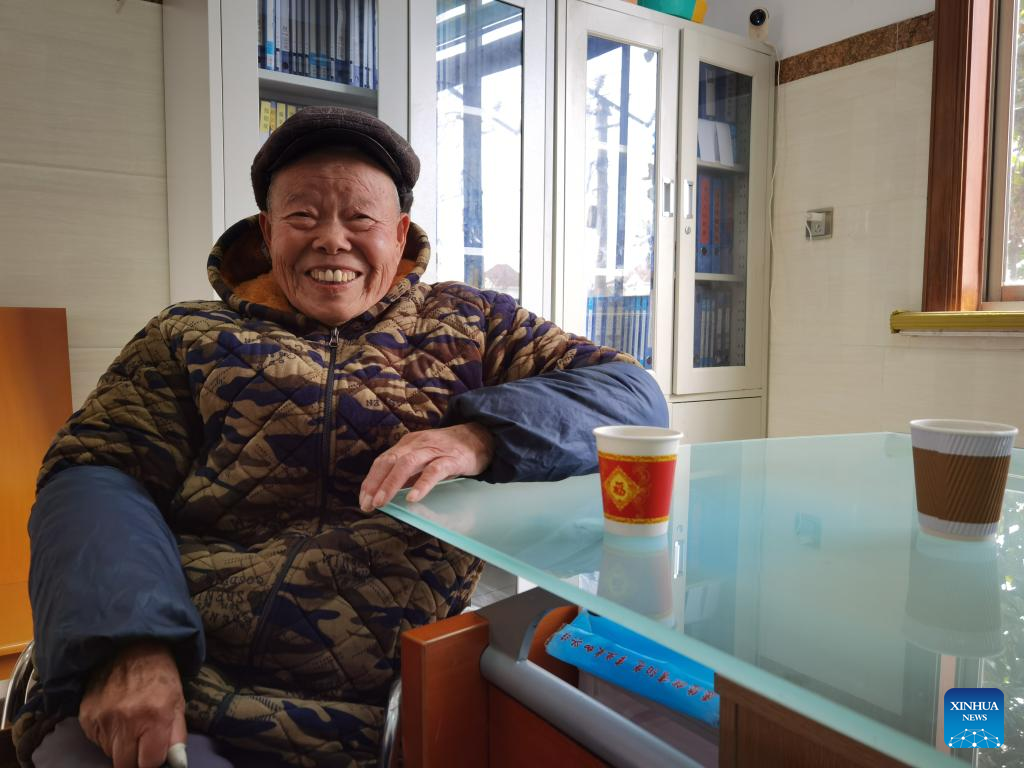Abandoned village schools become nursing homes

Zhang Yuyu is pictured at a nursing home in Linhaiqiao Village in Qidong City, East China's Jiangsu province, Jan 16, 2024. [Photo/Xinhua]
NANJING — After half a century, Zhang Yuyu is back where he first started work, at the Zhirong primary school in the city of Qidong, East China's Jiangsu province.
This time, however, the 89-year-old is no longer a math teacher, and the school has been turned into a nursing home for the elderly — counting Zhang among its residents.
The nursing home was founded by Zhou Biao, a Zhirong alumnus who was born in 1969, two years after Zhang started working at the school.
"There were more than 20 teachers," Zhou recalled. "My sisters all studied at the school."
As a consequence of China's policy of upgrading rural education, many small schools in the countryside were closed and the children were gathered into larger schools. Due to this policy, the Zhirong primary school stopped enrollment in 1996.
Zhou's nursing-home venture started with his elderly grandmother, who was in need of quality care.
"At that time, she was in her 90s, and didn't like the carers we found for her," said Zhou, who decided instead to start a nursing home and attend to his grandmother himself.
He returned to the village in 2009. By then the former school had become derelict and overgrown with tall weeds. Zhou managed to transform the place, building a main residential structure and three rows of houses for the staff. His grandmother lived in the nursing home until she was 104 years old.
Today, it accommodates more than 150 seniors.
In fact, many rural nursing homes like Zhou's used to be primary schools. In the 1970s and 1980s, primary schools run by villages were common in Jiangsu, where almost all the villages had their own schools featuring rows of classrooms and sandy courtyards. There were usually seven or eight teachers looking after several dozen students.
After many of the schools were abandoned, they were given a second life by their new owners. In Qidong, of the 44 nursing homes, 10 were once primary schools.
"I noticed in 2009 that the elderly population was growing in China's rural areas, but many of them had only one child," said Chen Hongping, owner of a nursing home in Chaoting village.
China's one-child policy, put in place in the late 1970s, was designed to curb population growth. It is widely believed to have contributed to the country's rising prosperity. The decades-long policy has been phased out since 2013, when the country allowed couples to have a second child if either parent was an only child. In 2016, married couples were allowed to have two children, and in 2021 they were allowed to have a third child.
On the other hand, China, like many other nations, is undergoing a demographic shift. By the end of last year, the number of people who were 60 years old or older had reached 297 million — including 217 million who were 65 or above — which accounted for 15.4 percent of the total population.
With 120 million people in rural areas age 60 or above, the country has been exploring solutions to care for seniors scattered across vast rural areas. The government issued a national-level guideline in June this year specifically on promoting rural elderly care.
At present, a lot of people who are only child in their families are feeling the pressure of supporting their parents.
"My daughter is also a single child," Chen said, adding that he discovered that nursing homes are good projects to invest in.
He decided to transform the former Tongkang Primary School into a nursing home because the school was "close to a national highway and a hospital, and spacious enough," and his idea was supported by the local government.
For each bed, the government gave Chen 5,000 yuan ($707) as a subsidy. He received a total of 525,000 yuan for his 105 beds.
In fact, such practices are not unique to Jiangsu. Elsewhere in China, such as in Shanxi province, people are also re-using abandoned school buildings in this way.
"Such nursing homes are welcomed by villagers, and it is the trend of old-age care," said Gu Shengping, a former village official in Qidong. "Most of the senior villagers have only one child, and they might be living in these nursing homes in the future."
Data from the Ministry of Civil Affairs shows that China currently has around 16,000 rural elderly care nursing homes that collectively provide over 1.68 million beds.
Zhao Yuyu, head of Qidong's civil affairs bureau, noted that making use of the abandoned schools could reduce the cost of nursing-home construction.
"The school buildings, especially those built after the 2008 earthquake, were of very good quality and could be transformed into nursing homes easily," Zhao said.
Zhang Yuyu, the former teacher, is happy with life in the nursing home.
"My life here is comfortable," he said. "The nursing home is close to my home, and I can go back whenever I want."





 TRANSPORTATION
TRANSPORTATION EDUCATION
EDUCATION HEALTHCARE
HEALTHCARE USEFUL NUMBERS
USEFUL NUMBERS